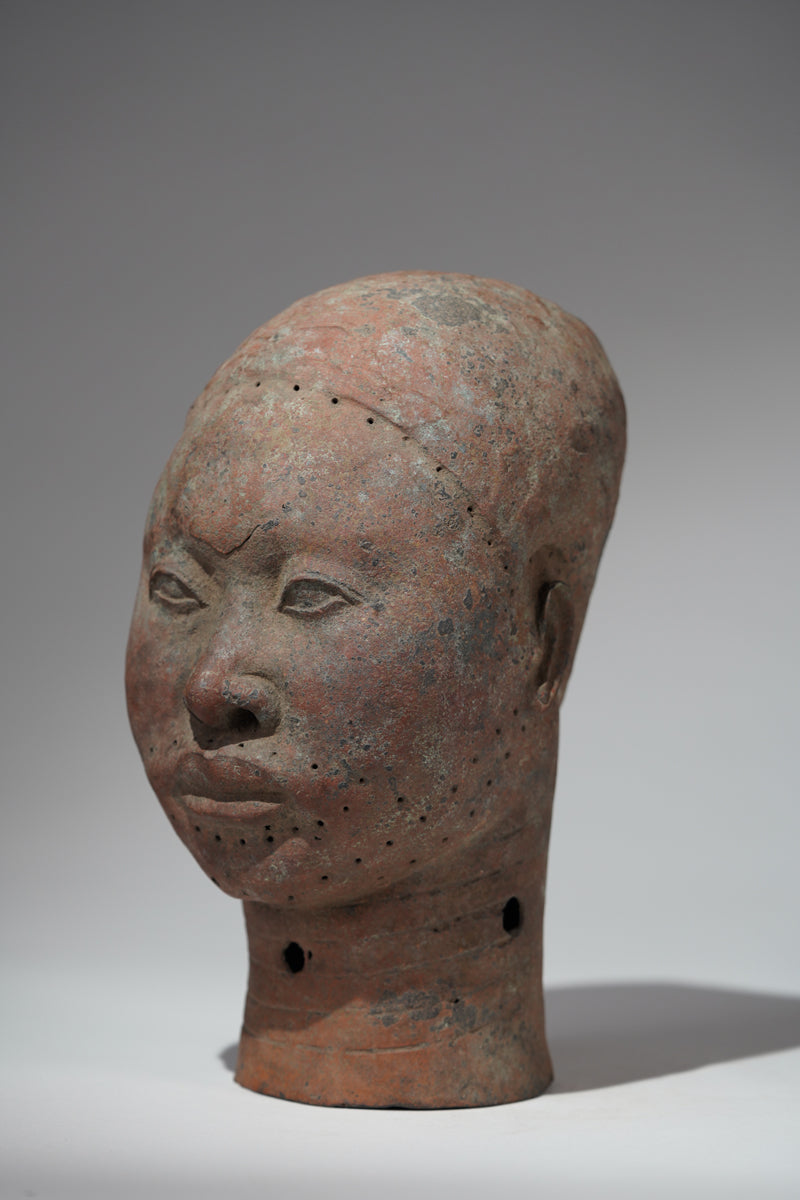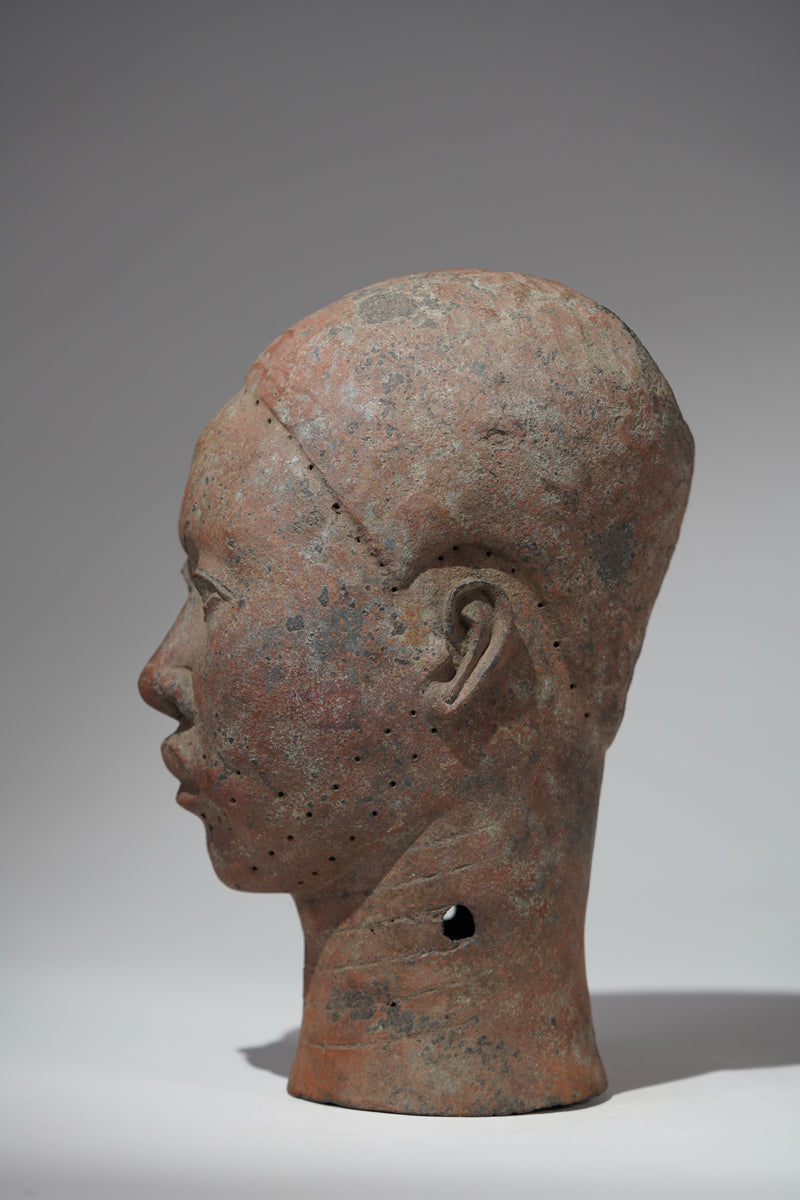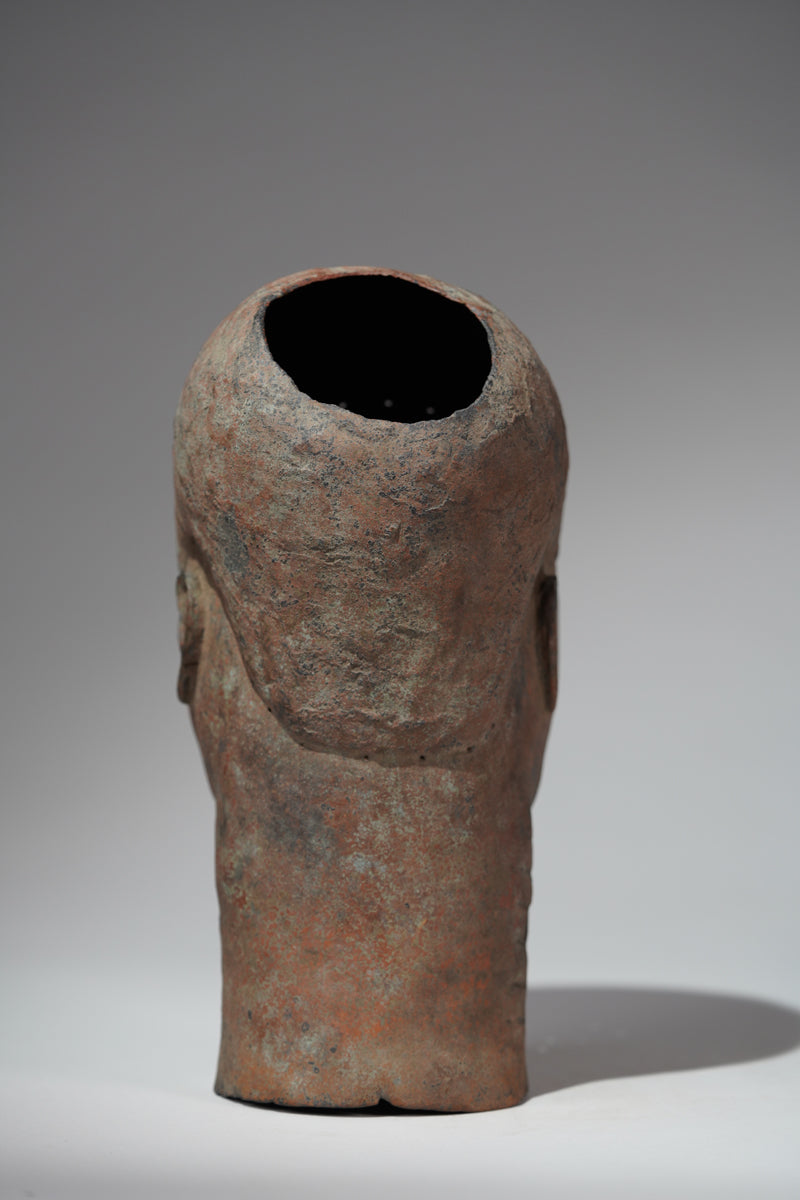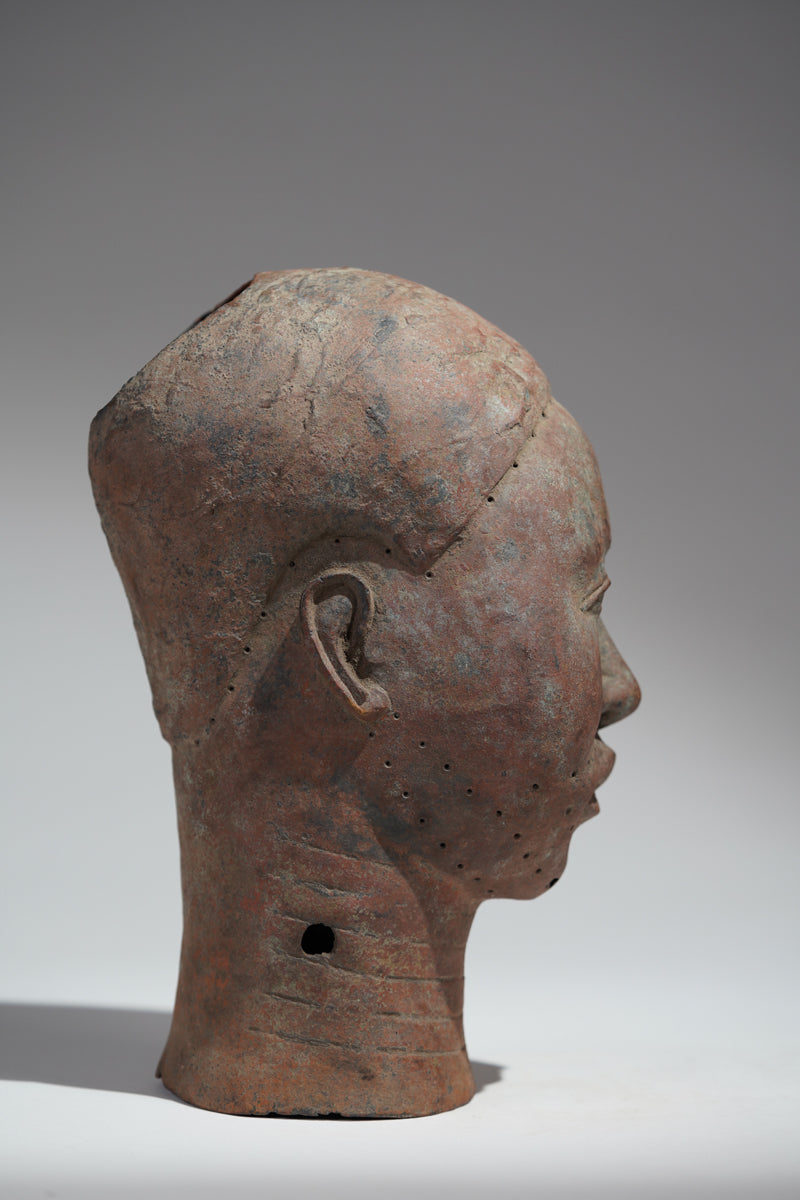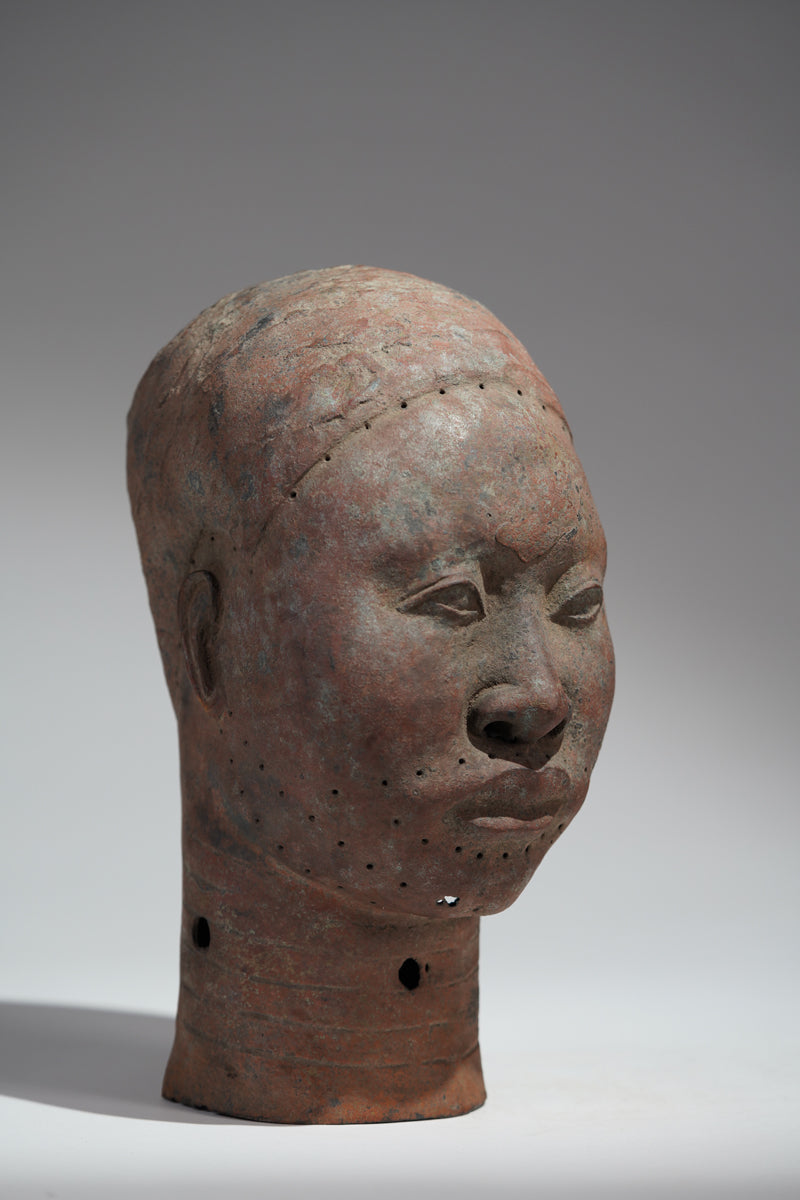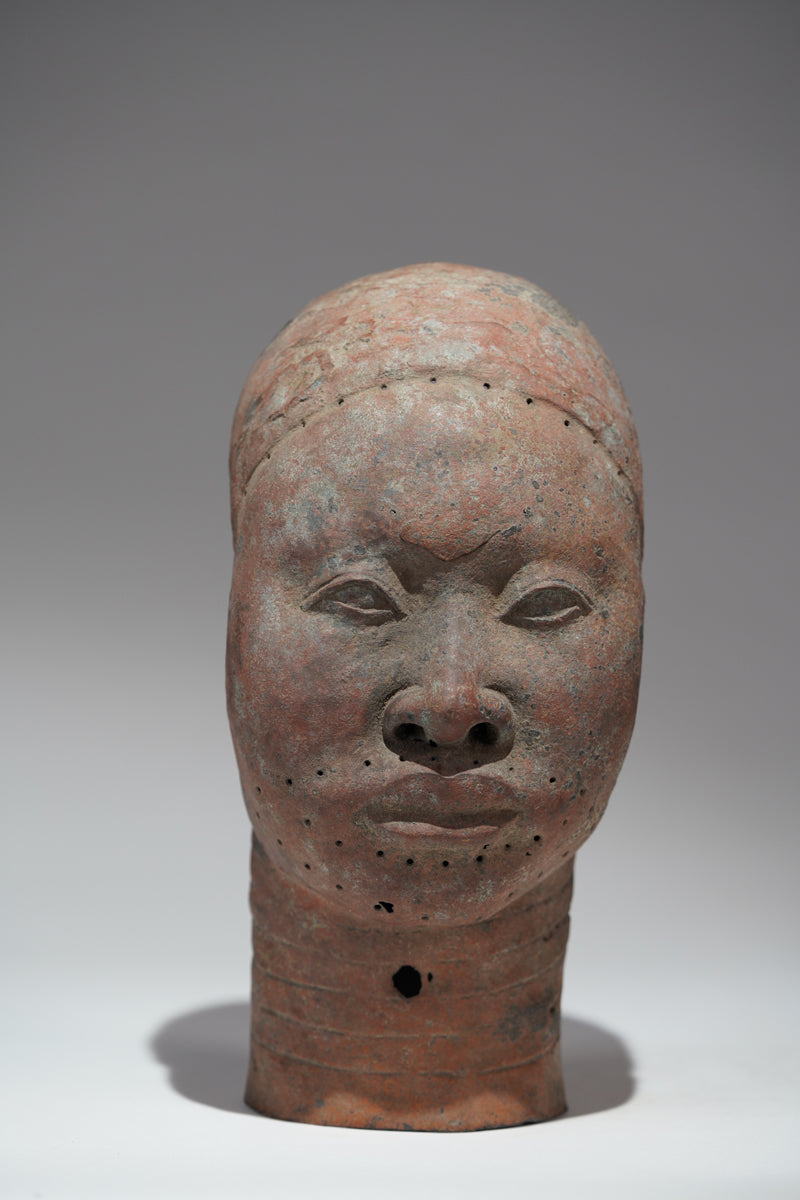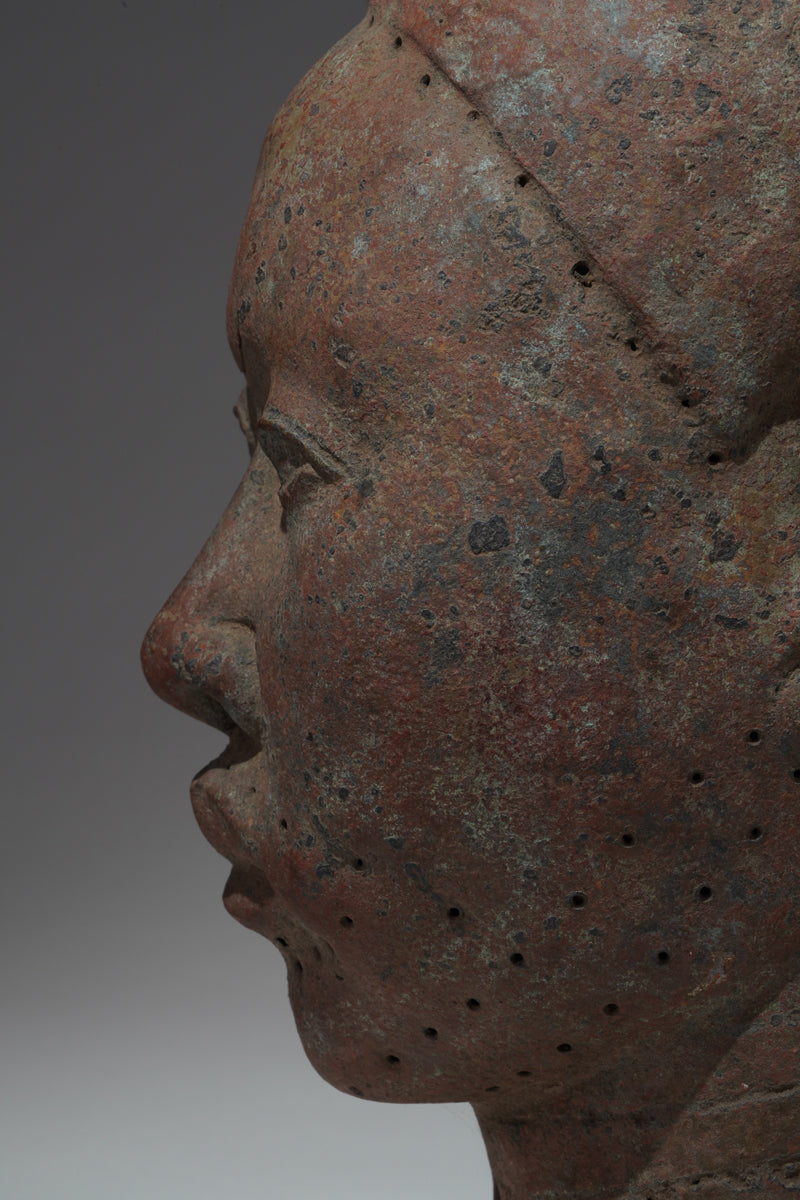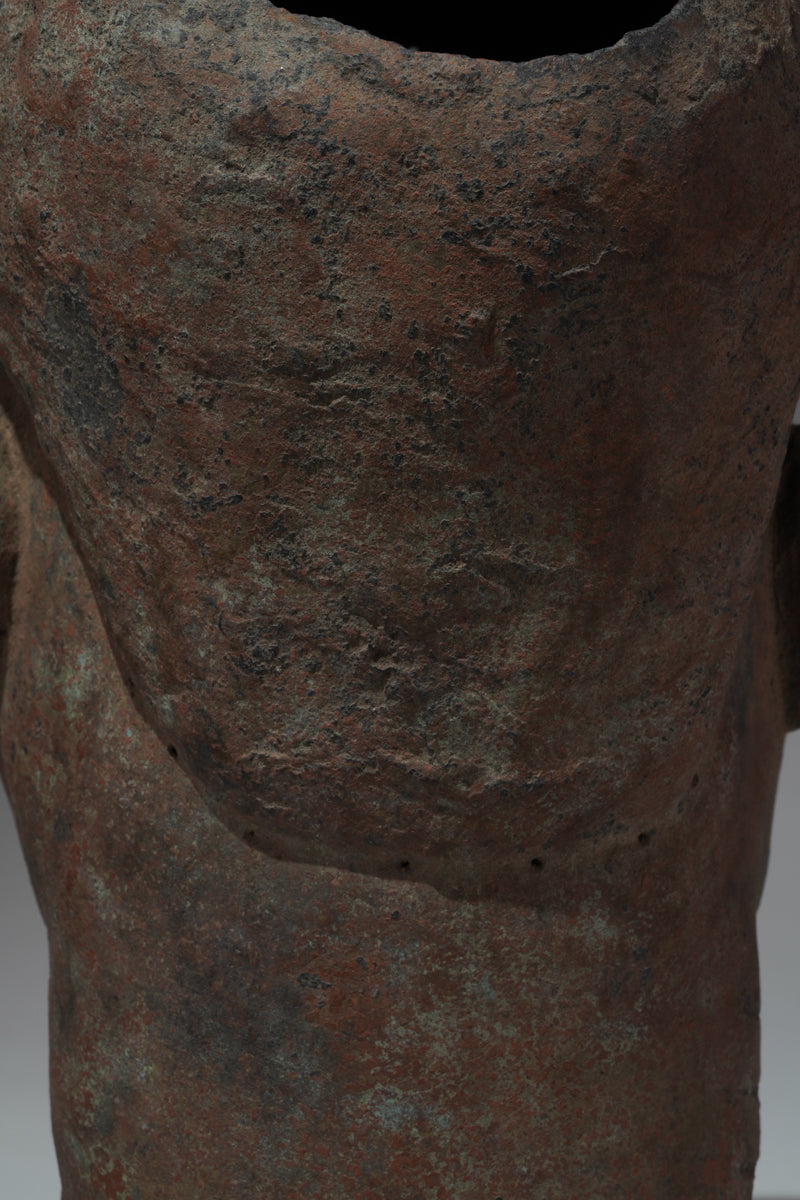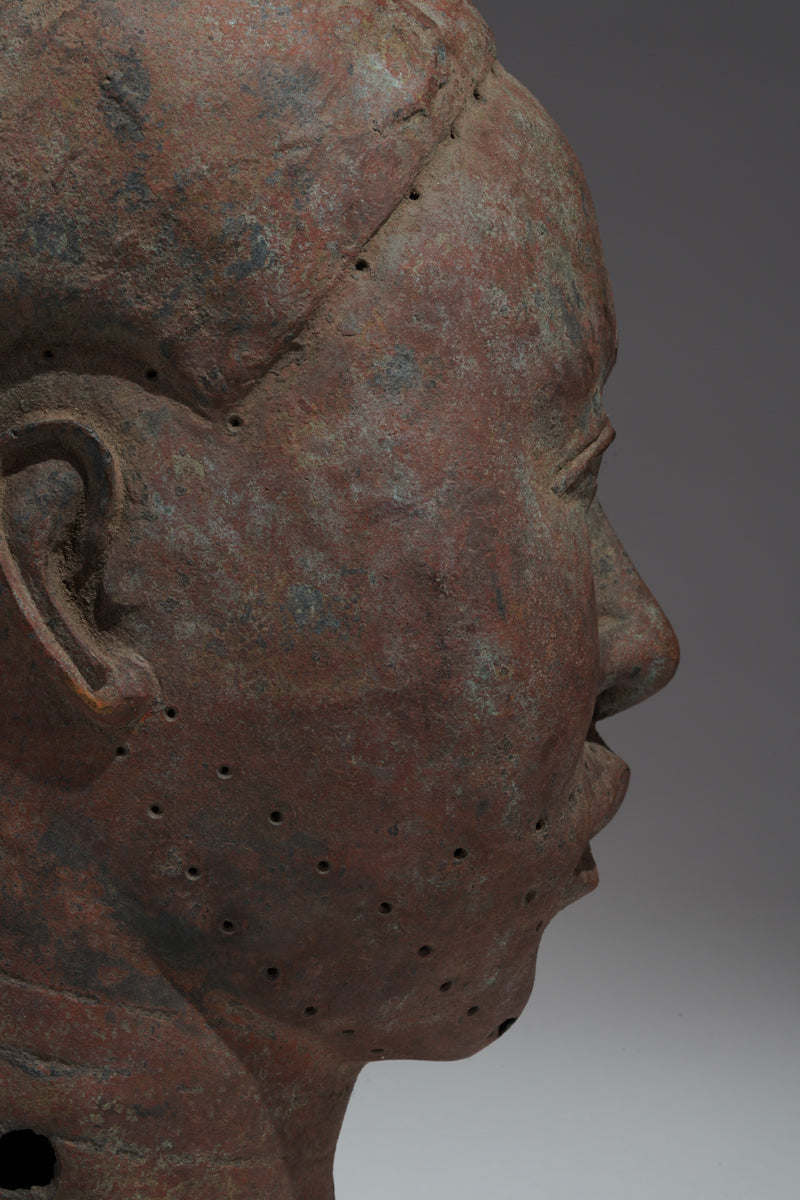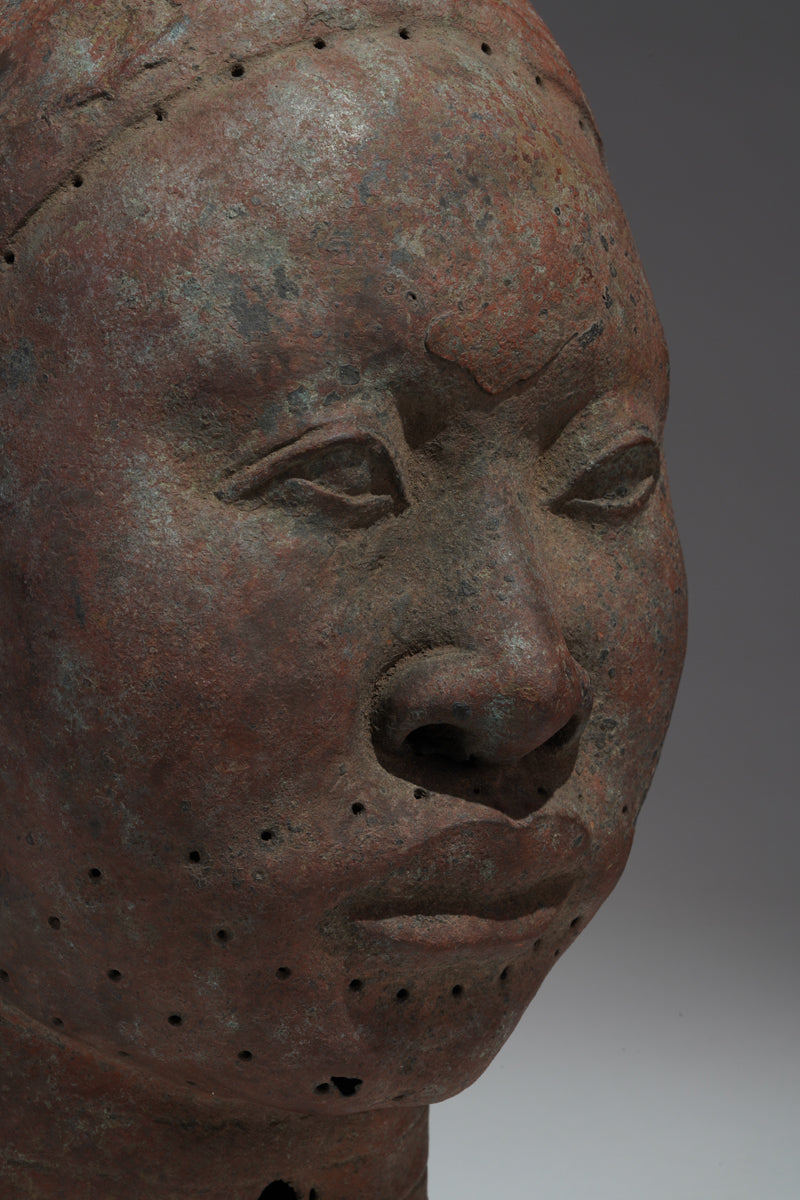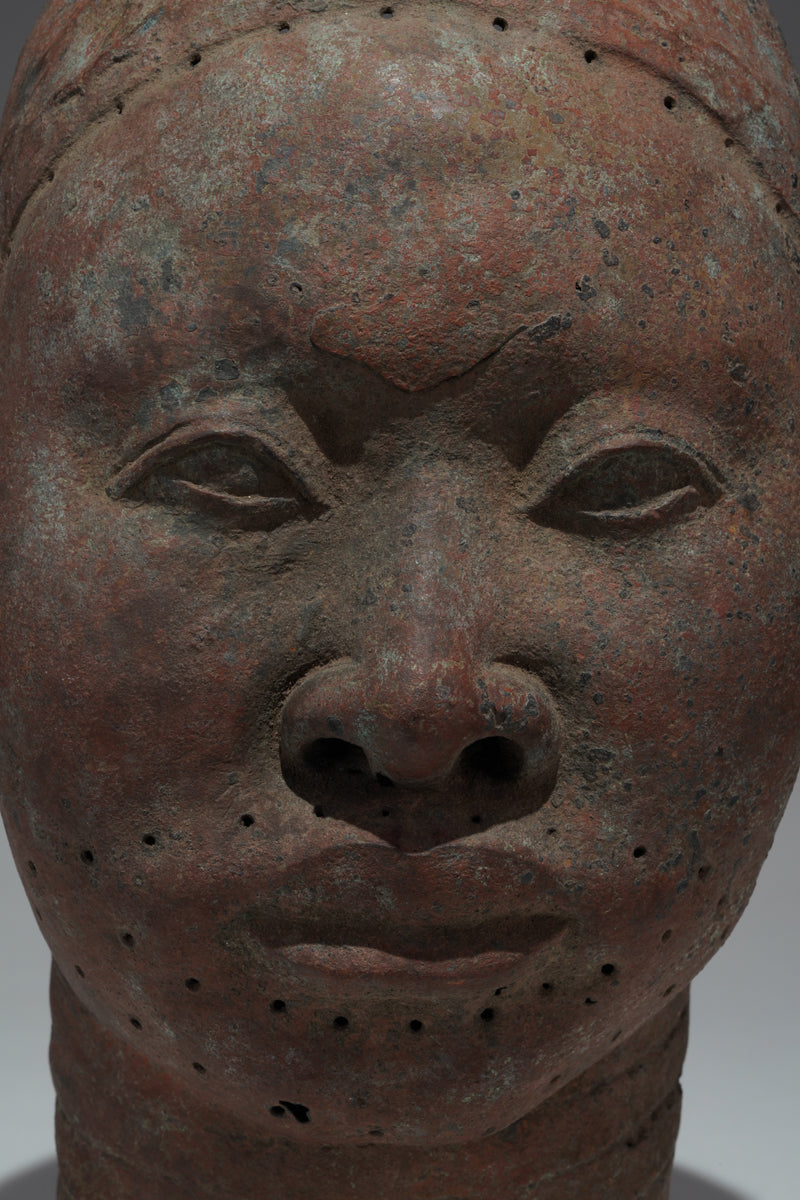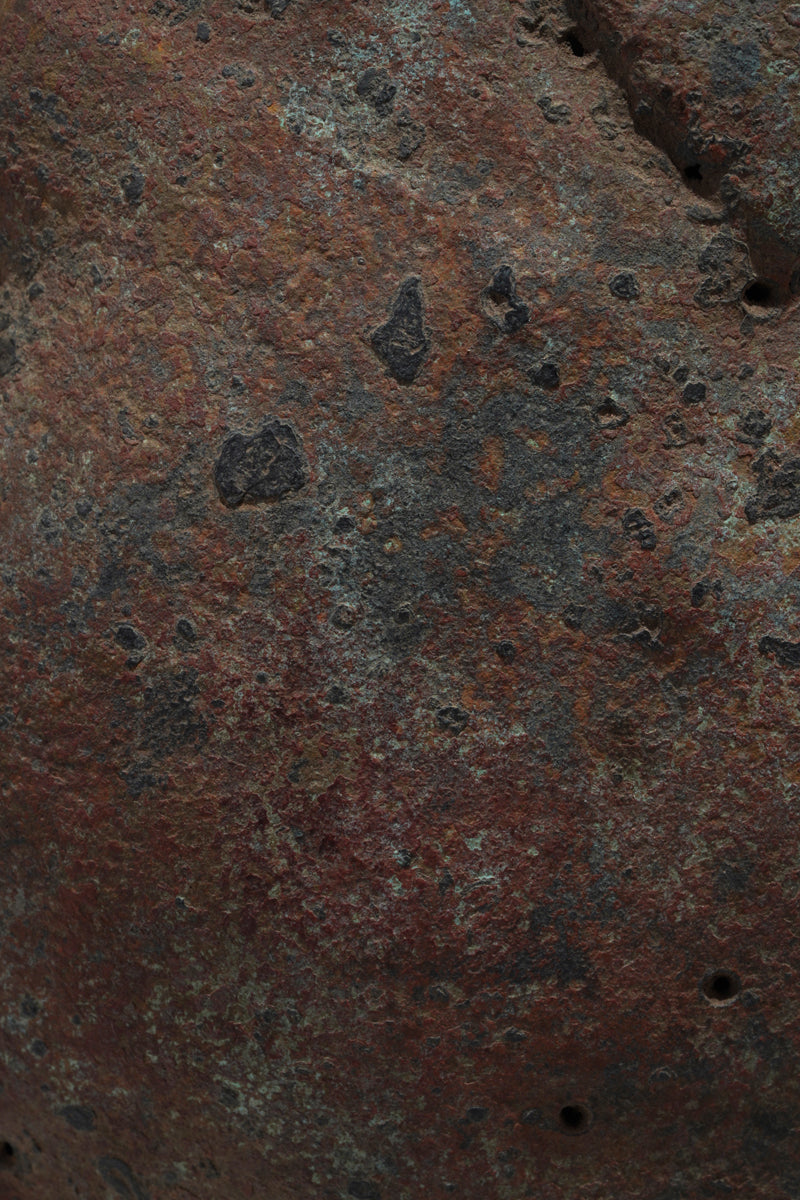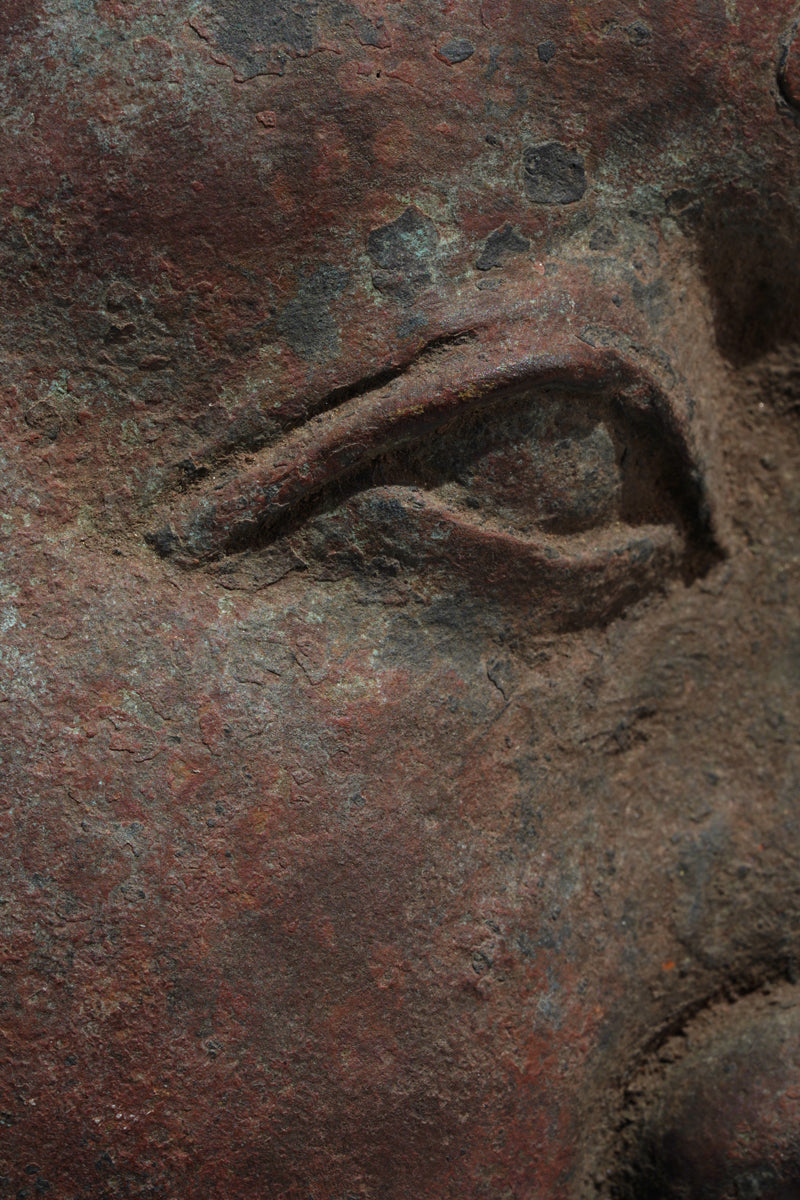wolfgang-jaenicke
A naturalistic, thinwalled bronze head
A naturalistic, thinwalled bronze head
Couldn't load pickup availability
A naturalistic, thinwalled bronze head, Nigeria, in the style of Ife, depicting probably a young (Ooni) Oba, characterized by the typical Ife style features: The corners of the upper eyelids hang over those of the lower ones. Around the lips is an accentuated edge, here especially around the upper lip. There are grooves around the neck, tiny holes pierced throgh around the mouth, cheekbone and hairline; the bronze is partly heavily encrusted with various layers of reddish brown patina, partly eroded, defects on the neck, the forehead close to the root of the nose, the obviously high copper content bronze with a low zinc content appears reddish, four openings in the neck for nails, with which the head was probably originally attached to a wooden body.
Similar bronze heads like the one of the Wunmonije Compound type are quite often found, which raises the question of their use. It is assumed that they were attached to a life-size wooden figure, possibly with movable limbs. These figures were dressed in the same way as the person depicted would have been. Perhaps the Oba was thus able to attend ceremonies and burials without being personally present. When a new Oba came into power, perhaps only the bronze head was replaced.
The naturalism exhibited in the Ife bronze heads stands in marked contrast to the stylistic conventions of ancient Egyptian portraiture. While both traditions are deeply concerned with representing human figures, their approaches reflect differing cultural values and artistic objectives. Ancient Egyptian portraiture, particularly that of the Old and Middle Kingdoms, prioritizes idealization and symbolism over individualized naturalism. Figures are typically depicted according to strict canonical proportions and conventions, which emphasize eternal order and social hierarchy rather than personal likeness. Faces in Egyptian sculpture and reliefs often display a formalized symmetry, with idealized features that communicate status, divinity, or moral qualities rather than specific individual traits.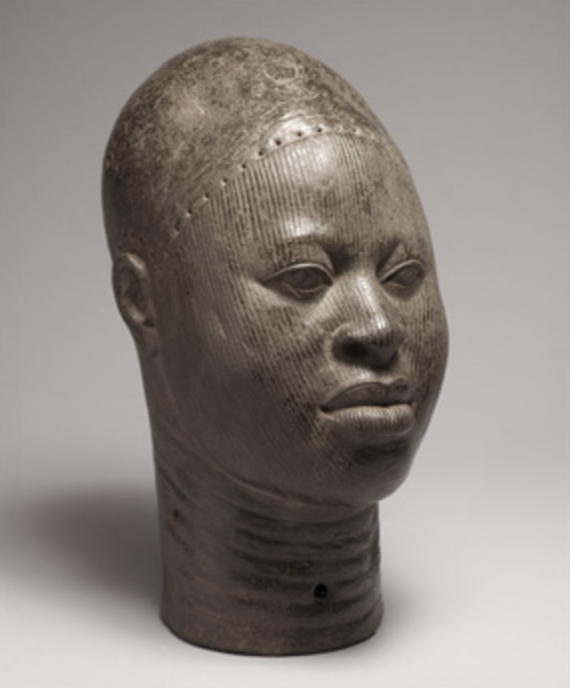
Ife head Wunmonije Compound.
In contrast, the Ife bronzes reveal a profound commitment to the observation and representation of individual physiognomy. The facial features are rendered with exceptional anatomical precision, including detailed modeling of skin texture, musculature, and subtle expressions that suggest unique personalities. This naturalistic portrayal implies a cultural emphasis on the individuality of the subject, often interpreted as royal portraiture or ancestral commemoration. The use of lost-wax casting technology allowed Ife artists to capture these nuances in bronze with remarkable fidelity, highlighting the technical and artistic sophistication of their tradition.

The Wunmonije heads at the British Museum in 1948. Published in Drewal (H.J.) & Schildkrout (E.), Dynasty and Divinity: Ife Art in Ancient Nigeria, 2009: p. 4, fig. 2.
Moreover, the different materials and artistic contexts further underscore the divergent aims of these traditions. Egyptian artists typically worked in stone or painted reliefs within funerary or temple settings, where art functioned as a vehicle for religious ideology and the perpetuation of cosmic order. Ife artists, by contrast, produced three-dimensional bronzes likely intended for ritual or courtly use, emphasizing the physical presence and individuality of their subjects within a living cultural framework.
Thus, while both cultures produced representational art that conveys social and spiritual meaning, ancient Egyptian portraiture embodies a stylized idealism rooted in theological and hierarchical concerns, whereas the Ife bronzes exemplify a naturalism that celebrates individual identity and artistic realism. These contrasting approaches highlight the diverse ways in which African and ancient Near Eastern societies conceptualized human representation.
If you want, I can also prepare a version with a more detailed historical background or add discussion on specific artworks from both traditions. Gay Robins, The Art of Ancient Egypt (Cambridge, MA: Harvard University Press, 1997), 45–48.
Henry John Drewal, John Pemberton III, and Rowland Abiodun, Yoruba: Nine Centuries of African Art and Thought (New York: The Center for African Art, 1989), 85–90.
Frank Willett, African Art (London: Thames & Hudson, 2002), 52–54.
Height: 31 cm
Weight: 2,1 kg
The Ife heads from the so-called Wunmonije Compound in Ile-Ife, Nigeria, are among the most significant examples of early West African art and Yoruba court culture. Their original function remains a matter of scholarly debate, but several interpretations have been proposed, including their possible role in royal funerary ceremonies.
The heads were discovered in 1938 during construction work in the Wunmonije Compound, located near the royal palace of Ife. The find comprised twelve to fifteen highly naturalistic brass or copper alloy portrait heads, along with some fragments, all cast using the lost-wax (cire perdue) technique. Their stylistic naturalism and technical refinement suggest a courtly context and date them roughly between the 12th and 15th centuries CE¹.
One prominent theory links the heads to royal burial rites. In Yoruba cosmology, the Ọọni of Ife is a sacred monarch, and his death initiates elaborate ritual processes. The heads may have functioned as effigies, or substitute representations of deceased rulers, used in ceremonies to honor the dead and facilitate their transition to the ancestral realm². In this interpretation, the heads were not mere portraits but active ritual objects embedded in the dynastic and spiritual continuity of the Yoruba monarchy.
The archaeological context complicates this theory. The heads were not discovered in formal graves but in a pit, suggesting intentional deposition or ritual burial. Some scholars propose that the site served as a repository for decommissioned or ritually potent objects no longer in active use. Others argue that the heads may have represented living kings and were used in rites of kingship, such as coronations or annual festivals³.
The proximity of the find to the palace reinforces the idea of royal and ceremonial usage. However, because there are no written records from the period of their production, interpretations must rely on archaeological evidence, oral tradition, and comparison with existing Yoruba ritual practices.
The proximity to the royal palace, however, appears to be of more coincidental significance, since, contrary to what is stated in the literature, these heads are relatively common among Ife bronzes. It can be assumed that they were found in all parts of present-day Yoruba territory. As with the Benin bronzes, there are considerable variations in artistic quality, ranging from absolute masterpieces to less prominent works. wj
¹ Frank Willett, Ifẹ in the History of West African Sculpture, London: Thames & Hudson, 1967.
² Henry John Drewal and Margaret Thompson Drewal, Gelede: Art and Female Power among the Yoruba, Bloomington: Indiana University Press, 1983.
³ Babatunde Lawal, “Yoruba Sango Sculpture and Its Religious Symbolism,” African Arts, Vol. 13, No. 2 (1980): 56–64.
